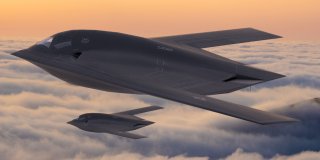These 5 Secret Warplanes Will Blow Russia and China Away
With its sights set squarely on countering Chinese threats in the Pacific and Russian aggression in Europe, the U.S. now has at least five secretive new warplanes in development.
During a keynote speech delivered at the Air Force Association’s 2022 Warfare Symposium earlier this year, Secretary of the Air Force Frank Kendall revealed that the United States is exploring the idea of an uncrewed stealth bomber platform that could fly missions ahead of the optionally-crewed B-21 Raider to expand upon America’s deep penetration strike capabilities in hotly contested airspace. This new bomber platform would be expected to have a “comparable range” to that of the new globe-spanning bomber, with payload capabilities to be determined in large part by price point… which is currently estimated to land somewhere near the incredible figure of $300 million or more per drone.
An unclassified Request for Information the Air Force has released to industry partners calls for this new drone stealth bomber to have at least a 4,000-pound payload capacity and a combat radius of 1,500 miles. Yet, as Aviation Week’s Steve Trimble has pointed out, it seems likely this aircraft will need to be able to match the B-21’s range in order to serve its purpose as a means of support on long-duration missions.
A substantially cheaper drone stealth bomber that can fly ahead of the B-21 Raider could offer a huge strategic value. Raider crews could use these uncrewed bombers to target anti-ship weapons that are too well defended to risk engaging crewed aircraft, or they could engage air defense systems to allow for a safer route to the objective. Of course, at half the cost of a B-21, we’re still talking about a drone stealth bomber that costs as much as three or more F-35s. Nevertheless, the F-35 very likely couldn’t reach these targets, to begin with, whereas these new drone stealth bombers will be able to.
With the B-21 expected to replace both the B-2 Spirit and the B-1B Lancer, it makes sense for the U.S. to consider fielding less-expensive drone stealth bombers as a supplement to its next-generation bomber fleets. This program is still in the early stages of development, with Air Force officials currently assessing which of the B-21’s systems should be migrated to the stealth drone and which can’t be due to cost limitations.
5) Mayhem: The highly secretive US Air Force effort to field a hypersonic stealth drone could finally bring the SR-72 to fruition
Hidden within the long list of hypersonic weapon programs drawing funds from Pentagon coffers, the Air Force Research Laboratory’s Mayhem Program appears to be developing a dual-cycle scramjet propulsion system for more than just missiles. The effort was originally tasked with fielding larger scramjet systems capable of propelling larger payloads further distances than unspecific “existing systems.”
Although Mayhem is regularly referred to as a missile program, a closer look at the branch’s issued Requests for Information (ROIs) suggests Mayhem is more likely aimed at fielding an uncrewed, reusable hypersonic drone platform capable of conducting two different specified mission sets: strike operations and intelligence, surveillance, and reconnaissance, or ISR, missions.
As Joseph Trevithick over at The War Zone noted late last year, Mayhem’s formal name recently changed from “Expendable Hypersonic Multi-Mission Air-Breathing Demonstrator” to “Hypersonic Multi-mission ISR and Strike,” and the effort has also been referenced as a “Multi-Mission Cruiser.” This strongly suggests that we’re not talking about a missile you fire at a target and forget about. The removal of the word “expendable” in conjunction with the “multi-mission” moniker both suggest Mayhem aims to field a reusable, autonomous platform that leverages what will likely be the world’s first dual-mode or turbine-based combined cycle (TBCC) hypersonic propulsion systems.
In other words, Mayhem aims to field a turbine-based scramjet system that can function at all airspeeds from subsonic to supersonic and then hypersonic. Today’s ramjet and scramjet systems don’t function reliably until they’re moving at extremely high speeds, which are currently achieved using rockets that fire before the propulsion systems come online.
This concept is tantalizingly similar to the longstanding discussion about Lockheed Martin’s planned successor to the Mach 3.5-capable SR-71 Blackbird, known as the SR-72. All the way back in 2018, Lockheed Vice President Jack O’Banion seemed to indicate that an SR-72 demonstrator may have already flown, and he stated clearly that a full-sized propulsion system had already been built and tested. “The aircraft is also agile at hypersonic speeds,” O’Banion told a crowd at the 2018 SciTech Forum, “with reliable engine starts.”
A hypersonic strike and ISR platform would have far-reaching strategic ramifications: from the ability to deliver less-expensive non-hypersonic ordnance to targets at speeds above Mach 5 to rapid intelligence gathering even in places where satellite coverage is compromised. While the world worries about who is fielding new hypersonic missiles, it seems the Air Force is secretly planning to win the hypersonic aircraft race before the rest of the world even knows it’s begun.
Editor’s Note: This article was originally published in August 2022.
Alex Hollings is a writer, dad, and Marine veteran who specializes in foreign policy and defense technology analysis. He holds a master’s degree in Communications from Southern New Hampshire University, as well as a bachelor’s degree in Corporate and Organizational Communications from Framingham State University.
This article was first published by Sandboxx News.
Image: Mike Mareen / Shutterstock.com

